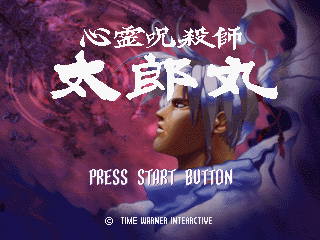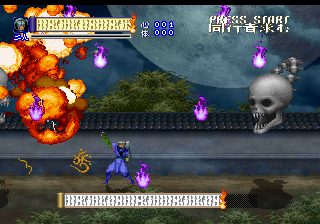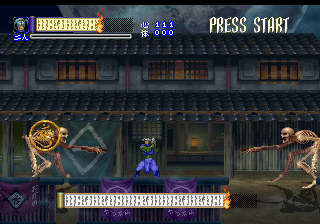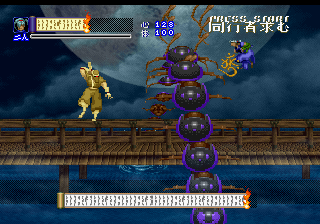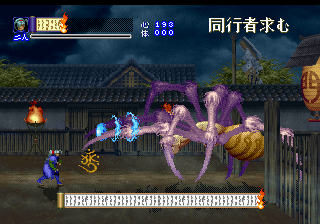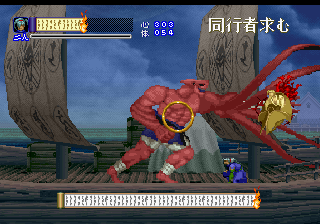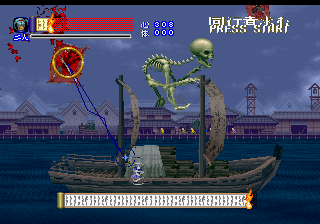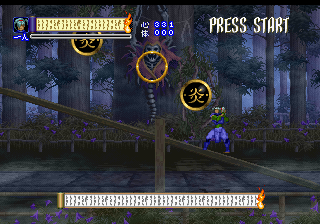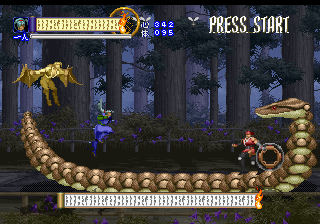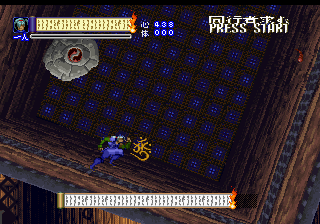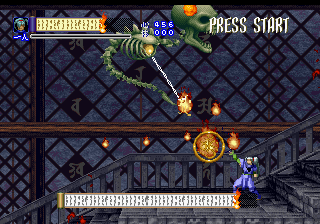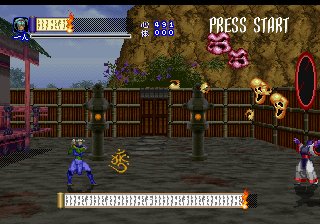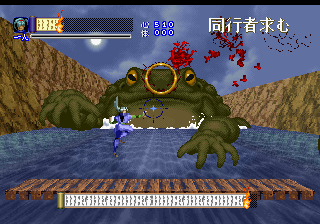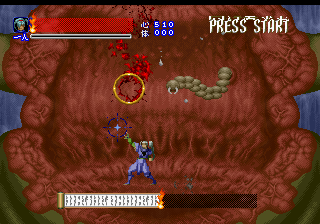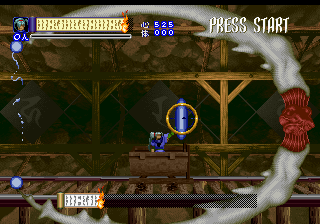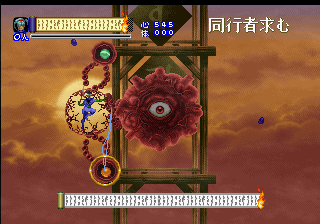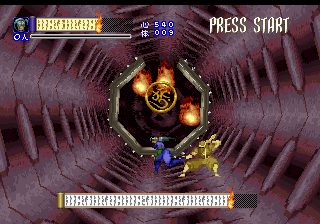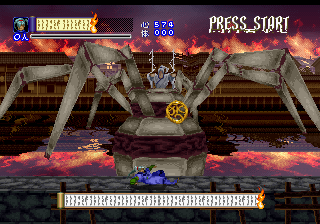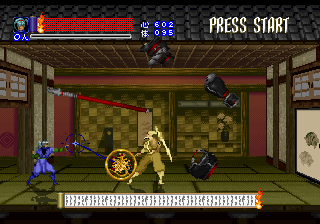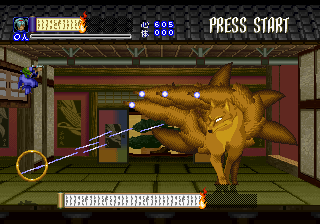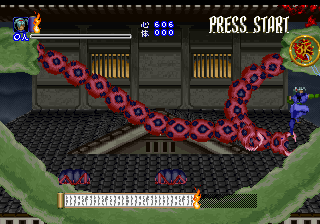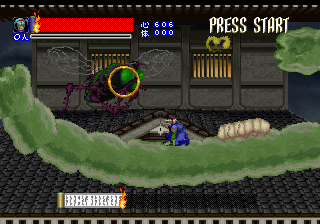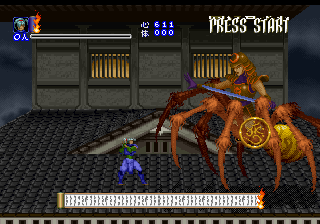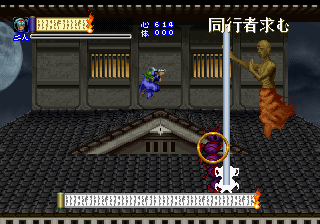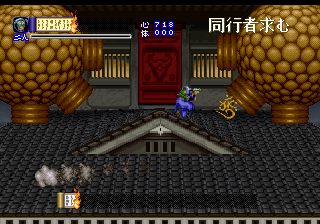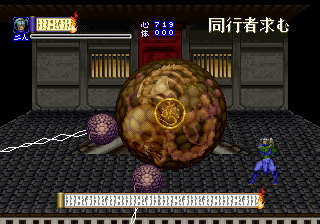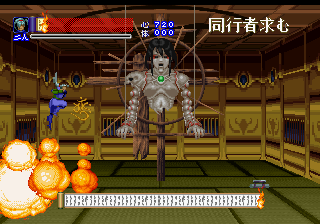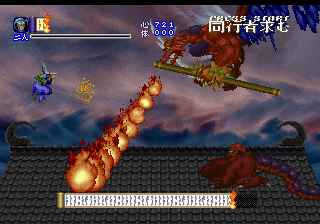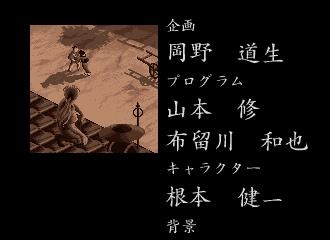Shinrei Jusatsushi Taroumaru
From Sega Retro
| Shinrei Jusatsushi Taroumaru | ||||||||||
|---|---|---|---|---|---|---|---|---|---|---|
| System(s): Sega Saturn | ||||||||||
| Publisher: Time Warner Interactive | ||||||||||
| Developer: Time Warner Interactive | ||||||||||
| Sound driver: SCSP/CD-DA (18 tracks) | ||||||||||
| Genre: Psychic Action (サイキックアクション)[1], Action[2] | ||||||||||
| Number of players: 1-2 | ||||||||||
|
Shinrei Jusatsushi Taroumaru (心霊呪殺師 太郎丸) is an action game, released by Time Warner Interactive for the Sega Saturn in 1997. The title translates to "Psychic Assassin Taromaru." It was only released in Japan.
Contents
Story
Two psychic ninjas, Taromaru and Enkai, battle an assortment of demons in feudal Japan to rescue a kidnapped girl.
Gameplay
The game is a side-scrolling action game set in a version of feudal Japan filled with mythological creatures. The player assumes the role of Taromaru or Enkai, psychic ninjas who fight their enemies with psychic powers and play nearly identically outside of minor differences in their attack ranges. The game uses 2D overlaid upon 3D backgrounds, with the perspective occasionally pivoting at predetermined points in the stages. Boss fights make up a significant portion of the gameplay and include an assortment of supernatural beasts and demons including large spiders and frogs. Interspersed between these boss fights are platforming sections with many lesser enemies.
The ninjas walk with ![]() and
and ![]() , run with
, run with ![]()
![]() and
and ![]()
![]() , and crouch with
, and crouch with ![]() . They jump with
. They jump with ![]() , jump off platforms with
, jump off platforms with ![]() +
+![]() , and slide along the ground with
, and slide along the ground with ![]() +
+![]() . They can raise a magical shield with
. They can raise a magical shield with ![]() that pushes back enemies and absorbs projectiles. This shield cannot be invoked when walking but can be used at any other time, including while in midair.
that pushes back enemies and absorbs projectiles. This shield cannot be invoked when walking but can be used at any other time, including while in midair.
The ninjas can fire a quick burst of psychic energy with ![]() or charge up their energy for a more destructive attack by holding and releasing
or charge up their energy for a more destructive attack by holding and releasing ![]() . Most enemies require multiple hits to be defeated. The charged attack is slower to use but more powerful and can hit multiple enemies. Similar to Alisia Dragoon, nearby enemies are targeted automatically. A reticle indicates which enemy is going to be attacked, and the player can cycle through possible targets with
. Most enemies require multiple hits to be defeated. The charged attack is slower to use but more powerful and can hit multiple enemies. Similar to Alisia Dragoon, nearby enemies are targeted automatically. A reticle indicates which enemy is going to be attacked, and the player can cycle through possible targets with ![]() and
and ![]() . Bosses often have multiple possible spots to attack, with some taking more damage than others (and some not taking any damage at all). The ninjas can fire while crouching or jumping but not while moving (though the psychic attack can be charged while moving).
. Bosses often have multiple possible spots to attack, with some taking more damage than others (and some not taking any damage at all). The ninjas can fire while crouching or jumping but not while moving (though the psychic attack can be charged while moving).
In addition to the main attack, the ninjas can hypnotize certain types of enemies into fighting alongside them with ![]() . This ability is targeted in the same manner as the psychic attack and can be charged up. Like the psychic attack, it takes multiple hits to hypnotize an enemy. Only one enemy can be hypnotized at a time. Hypnotized enemies last until they run out of life, but the player can also cause them to explode, which damages everything on the screen, with
. This ability is targeted in the same manner as the psychic attack and can be charged up. Like the psychic attack, it takes multiple hits to hypnotize an enemy. Only one enemy can be hypnotized at a time. Hypnotized enemies last until they run out of life, but the player can also cause them to explode, which damages everything on the screen, with ![]() or
or ![]() .
.
Each ninja has a health bar, depicted as a burning scroll on the top of the screen. The bar reduces in size as the ninja is injured by enemies. The ninja loses a life if the health bar is emptied but revives momentarily if the player has lives remaining. The game ends if a player runs out of lives but can be continued. The number of remaining lives is shown as a Chinese numeral rather than an Arabic numeral (for example, 一 for one and 二 for two). Characters have a brief period of invulnerability after taking damage or being revived. Bosses have their own health bars that appear on the bottom of the screen, again looking like a scroll, and hypnotized enemies have their health shown as a number in between the players' health bars.
The game has a two-player cooperative mode where both ninjas fight together. The second player can join the game at any point during gameplay by pressing START .
Items
| Restores a quarter of the ninja's health. | |
| Restores half of the ninja's health. |
Stages
Though the game is broken down into stages, which are marked by text overlays, there is no break between stages, so the game plays out as one long, continuous journey.
| 子ノ刻 (Hour of the Rat) | |
|---|---|
| 卯ノ刻 (Hour of the Rabbit) | |
| 辰ノ刻 (Hour of the Dragon) | |
| 巳ノ刻 (Hour of the Snake) | |
| 申ノ刻 (Hour of the Monkey) | |
| 戌ノ刻 (Hour of the Dog) | |
| 亥ノ刻 (Hour of the Pig) | |
History
Development
The game was developed by Time Warner Interactive's Japanese studios. Hiroshi Iuchi, known for his work with Treasure, did some of the art design. Characters were designed by Kenichi Nemoto.
Reportedly, only 7,500 copies of the game were made since Time Warner Interactive was in the process of closing operations when it was published.[3] As a result, it is one of the rarest and most expensive Saturn games on the aftermarket.
Production credits
- 企画: 岡野 道生
- プログラム: 山本 修, 布留川 和也
- キャラクター: 根本 健一
- 背景: 井内 洋, 岡野 道生, 川端 康子
- 音楽: 横山 賢司, 塙 俊一
- マニュアル: 吉岡 瑞穂
- 題字: 柳 操
- 声の出演: 松竹 貴之, 守屋 雄一郎, 工藤 ゆき子, 平澤 佳子
- 営業: 北原 唯史
- 広報: 小野寺 千枝, 倉下 かおり, 梅田 直子
- 協力: 土屋 直樹, 大窪 智典, 小松 健祐, 七条 泰弘, 吉岡 文彦, 横瀬 さとみ, 野口 貴志, 山崎 陽, 山崎 浩, 松永 一夫, 順不同
- Presented by Time Warner Interactive
Magazine articles
- Main article: Shinrei Jusatsushi Taroumaru/Magazine articles.
Promotional material
Physical scans
| Sega Retro Average | |||||||||||||||||||||||||||||
|---|---|---|---|---|---|---|---|---|---|---|---|---|---|---|---|---|---|---|---|---|---|---|---|---|---|---|---|---|---|
|
| 67 | |
|---|---|
| Based on 5 reviews | |
Technical information
- Main article: Shinrei Jusatsushi Taroumaru/Technical information.
References
- ↑ File:SJT Saturn JP Box Back.jpg
- ↑ 2.0 2.1 https://sega.jp/fb/segahard/ss/soft_licensee3.html (Wayback Machine: 2020-03-20 23:05)
- ↑ [ ]
- ↑ File:Shinrei Jusatsushi Taroumaru Saturn credits.pdf
- ↑ Famitsu, "1997-01-24" (JP; 1997-01-10), page 1
- ↑ Saturn Fan, "1997 No. 1" (JP; 1996-12-27), page 201
- ↑ Saturn Fan, "1997 No. 5" (JP; 1997-02-28), page 98
- ↑ Sega Saturn Magazine, "1997-01 (1997-01-17)" (JP; 1996-12-27), page 234
- ↑ Sega Saturn Magazine, "Readers rating final data" (JP; 2000-03), page 12
| Shinrei Jusatsushi Taroumaru | |
|---|---|
|
Main page | Magazine articles | Reception | Technical information | |
